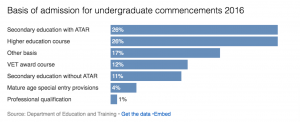Beyond the ATAR
Beyond the ATAR
In September 2019, O’Connell, Milligan and Bently published a position paper called “Beyond the ATAR: A proposal for Change” that examined the transition between school to higher education, life and work and what this meant for our current generation of 15-19 year olds.
The paper argued that the challenges facing 15 to 19 year olds were that for over half of all young people, transition from school to full time work can take over 5 years. The pathway to full time work comes from part time, casual and piece work. This, along with other reports emphasise that better career planning is required to support young people’s transition to their future.
The proposal for this paper was three fold:
1. A distinctive phase for young people aged 15-19 – That the age of 15-19 year olds is rescued as a development stage where students are “supported to develop knowledge skills and capabilities within various domains”, particularly with a growing awareness of their capabilities linked with their futures and exposing them to different options that build their unique “interests, capabilities and aspirations” At St Luke’s, students start as early as year 5 and 6 building an awareness of careers and in year 7 examine their strengths, interests and motivations with the help of our onsite Innerzone to understand themselves and the problems they want to solve early on. In years 9-12, this develops from an inside-out approach to bringing the outside in, with development in year 9 of an Odyssey Plan through to them proposing the future of their study in year 10. Working shoulder to shoulder, teachers support by helping students unpack the last two years of their life design journey and apply this to designing their future pathways – including multiple options. In year 11 this year, we have started offering students the opportunity to engage with external partners, private colleges, universities and TAFEs to expose students to greater opportunities. We are also very proud to have supported a number of students in obtaining traineeships and internships with employers and engaging in a number of VET Certificate qualifications from as early as year 9, which will see students with reduced workloads and more time in year 11 and 12.
2. Building of a learner profile – That a learner profile be built to provide a full range of attainment over a broad range of domains. St Luke’s develop this from kindergarten to year 10 with the use of Seesaw and then blogs as a portfolio of their work and reflection on what they do, to year 9 where students develop a website portfolio of the very best of what hey can do, and what problems they want to solve. This is supplemented by a reporting process that emphasises capabilities in addition to grades for each student. This is currently being developed further into a student dashboard which tracks student growth in their capabilities across time. It was interesting to note at a recent conference, Adobe spoke about how a student who was engaged in their own businesses, or had a portfolio of work were given greater value to their resume and were more likely to obtain jobs at Adobe.
3. Moving tertiary selection beyond the ATAR – That universities look at broader entry requirements that move beyond just the ATAR. We have seen this already with the introduction of portfolio based entries, diploma based entries and programs like early entry and adjustment factors. The Mitchell Institute in 2016 tracked data that said only 26% of students used their ATARS for direct entry into university. In fact, 12% of students received offers to university on the basis of doing a VET certification, which at St Luke’s can start as early as year 9. Here at St Luke’s, through our Life Design program we are also seeing that students are more aware of who they are and what they want to do, and are engaging in opportunities that will accelerate this prior to completing the HSC.

Finally, there was a recognition that most of the jobs to be created in the next five years will require some form of post school qualification, so all students need to be prepared to be lifelong learners.